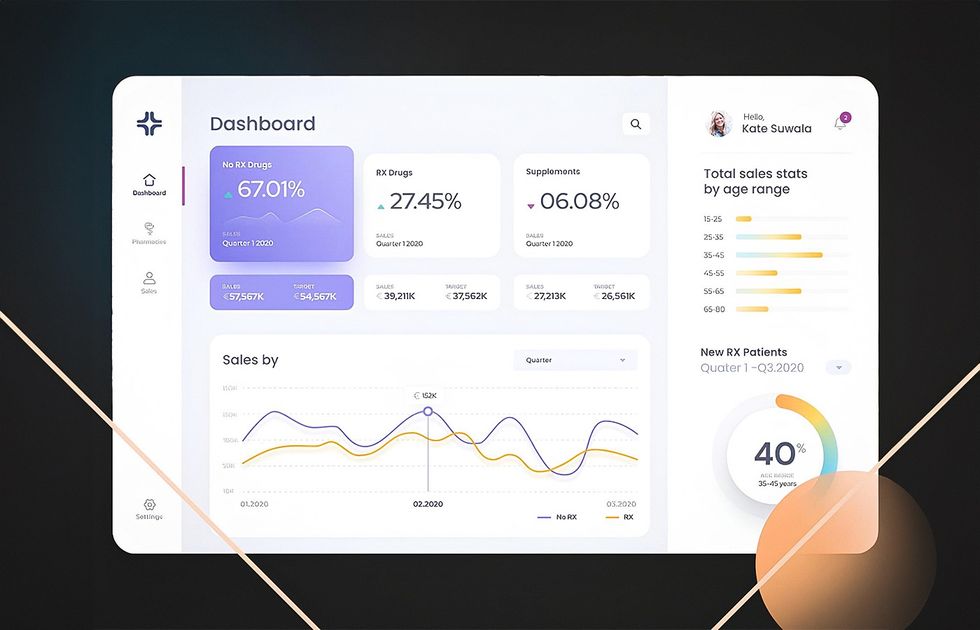
Key Takeaways
- Online pharmacy apps provide inner process systematization, increasing efficiency, expanding client base, more security and control, and better customer experience.
- When building a pharma app, don’t forget to include customer, pharmacist, admin, and courier modules.
- In pharmacy app development, it’s essential to consider legal regulations like HIPAA, GDPR, HITECH, DSCSA, CSA, etc.
Implementing robotics and artificial intelligence (AI) reduced production expenses and improved efficiency, leading to pharmacy market growth. People’s spending on medicines (offline and using pharmacy applications) is going up — in 2022, it was valued at $1.48 trillion.
Patients are used to smartphones and online shopping. That’s why they are looking for a more convenient and faster way to get medicines. The industry finds a solution in pharma app development focusing on convenient and timely medicine delivery. However, developing such a product requires compliance with additional rules and requirements, making it more challenging.
As a pharma app development company, Acropolium has 11 years of experience delivering advanced products. In this article, we’ll discuss the main aspects of pharmaceutical product development based on our experience working with related cases. You will find the typical user flow, key features, possible challenges, and compliance requirements. Let’s get started!
E-Pharmacy Market Share
In 2022, the e-Pharmacy market surpassed $98.8 billion in size, and it is projected to expand at over 14.5% CAGR between 2023 and 2032. This substantial expansion is driven by the rising prevalence of smartphones and the growing adoption of internet-based applications.

Business Benefits of Custom Pharmacy Apps
Here is how pharmaceutical businesses and consumers could benefit from online pharmacy app development.
Inner Process Systematization
Paperwork, constant reports, and data operations overburden the pharmacists’ and administrators’ responsibilities. Entrusting complex internal processes to an efficient software solution will save pharmacists much time dealing with more urgent matters.
Increasing Efficiency
Internal systematization and digital solutions lead to increased efficiency. Adding analytical features to your app will also provide you with valuable data. You may measure the employees’ productivity, sales and marketing funnels efficiency, and discover the target audience’s needs, etc.
Expanding Client Base
Pharmaceutical software development will bring you more customers by gaining their loyalty with the help of practical tools. Push notifications, discounts, special offers, and accelerated delivery will attract people and increase the profit.
Gaining More Security and Control
The application’s compliance guarantees cybersecurity with the required regulations, such as HIPAA. At the same time, admin panels provide comprehensive control over internal databases and systems.
Relieving Customer Pains
The pharmacy’s customers won’t have to waste time waiting in lines. Also, pharmaceutical apps enable people to compare prices and have a much wider choice.

User Experience Flow in Pharmacy Apps
The main goal of such an app is to provide clients with a convenient and direct way to search, select, order, and receive the desired medications.
Let’s reveal a typical customer journey mapping (CJM) to learn the basics of a pharma app’s user flow.
- After entering the app, a customer searches for the required medicine. You should provide users with a convenient search bar. The filters will help reduce looking-for time. It’s also worth enabling the option to upload an electronic prescription.
- A customer should contact the pharmacist via phone or message if a more detailed consultation is needed.
- After selecting the medications, a customer adds them to the card.
- In the payment section, a customer fills out the form with their delivery date and address. Simplify this process for registered users. For new users, provide quick and clear onboarding.
- A customer selects the payment method. You should offer a few payment options, including credit card, PayPal, online wallets, etc.
- After the payment confirmation, the order is prepared by pharmacy workers and handed over for delivery.
- Enable customers to track their orders in the corresponding app section.
Here is how a client-side CJM looks typically:

Pharmaceutical App Features
Before diving into the pharma app features overview, let’s discuss its most widespread types:
- Apps for pharmacy marketplaces. These apps serve as digital platforms where multiple pharmacies can list their products and services. Users can access a wide range of medicines and healthcare products through a single app. Examples: Glovo and Roadie.
- Apps for online pharmacy stores. They represent a specific online pharmacy’s digital presence, allowing users to directly purchase medicines and healthcare products. Examples: Ride Aid and Pharm Easy.
- Apps for pharmacy store chains. Such solutions are designed for pharmacy chains with multiple physical store locations. They provide a digital extension of the chain’s services and offer various conveniences to customers. Examples: GPC Mobile and CARiNG Pharmacy. A common online pharmacy software should consist of four parts:
Customer App
These best practices of modern eCommerce platforms will help you build your own pharmacy app. UI/UX design should provide an intuitive interface, clear navigation, and user-friendly features.
Here are some basic features of a customer pharmacy app:
- User registration and profile
- Search functionality with name, brand, and category filters
- Information about medication dosage, side effects, and instructions
- Medicine availability and pricing
- Prescription storage for easy reordering
- Multiple payment options
- Real-time order tracking
- Push notifications
- Medication refill reminders
- Map with nearby pharmacies or pick-up points
- User reviews and ratings
- Social media integration

Easy Sign-in, Onboarding, and Log-in
Simplify registration and log-in processes by enabling entrance using an email, phone number, or social media account. Don’t overwhelm users with too much information.
Search with Filters
The ability to filter goods by category will save a lot of time for customers. Also, you may enable users to find the nearest pharmacies on the map.
Information about Drugs and Comparison
Allow the users to view details about the chosen medicine. Provide them full information about the drug, its manufacturer, contraindications, instructions, etc. Also, add price comparison and substitute search.
Prescription uploading
A customer should be able to upload the prescription received from their doctor. It’s crucial for pharmacists’ verification and purchasing legality.

Cart and Payment
Provide the users with a sufficient choice of payment methods, including credit or debit cards, online wallets, crypto wallets, etc. Allow the buyers to check the order details before confirming the purchase and provide a simplified reorder option.
Push Notifications
Implement this feature to report order status, remind you to take medications, and notify you about discounts, promotions, and special offers.
Order Location Tracking
Order tracking is one of the key functions. With its help, customers can see the current status of their orders. It can be displayed on a map for complete clarity.
User Profile
The registered users should be able to create their profiles by filling in basic personal information. Registration may be optional. But you can offer authorized users special discounts and other benefits. Enable updating profiles by editing addresses, payment details, etc.
Communication Features
Many customers may need a pharmacist’s professional consultation or advice. An online drugstore can meet this goal as well. Allow users to contact specialists by messaging or calling them inside the app.

Pharmacist Panel
Pharmacist software serves the needs of professionals. They need a tool to manage orders, verify prescriptions, provide consultations, etc. A pharmacist panel should automate certain processes to reduce paperwork and improve management.
The main features of the pharmacist panel include:
- Dashboard with incoming orders, prescription requests, and inventory status
- Order management
- Prescription verification
- Inventory management
- Patient profiles and prescription history
- In-app messaging for communication
- Push notifications
- Reports on order history, sales, and inventory

Order Management
Users should receive notifications about the orders, accept them, and change statuses. They may also have to contact medication providers to request unavailable drugs.
Prescription Verification
Pharmacists should receive prescriptions, ask for them if required, and verify if they are genuine.
Warehouse Systems Integration
Pharmacists should have access to warehouse systems to replenish the stocks.
Admin Panel
The admin panel conducts maintenance and deals with databases, logs, and the entire system organization. It should be equipped with features for analytics, reporting, and centralized management to provide pharma solution management.
Key features of the pharmacist dashboard admin panel include:
- Dashboard with user activity, order status, and system performance
- User role assignment and access control
- App content management and updating
- Order management
- Pharmacy profile management
- Inventory management across all pharmacies
- Prescription verification
- Reports on user activity, order trends, and app performance
- Communication between users, pharmacists, and customer support
- Transactions and financial records monitoring
- Security and compliance measures
- App analytics and performance
- Third-party integrations

Analytical Tools
Analytical tools such as dashboards will provide timely reports and control over data regarding sales, employees’ performance, customers’ needs, and so on. This information will help administrators optimize the workflow and improve business strategy.
Payment Management
This feature is for tracking payments and ensuring customers’ banking data security.
Inventory Management
The pharmacy’s inventory requires constant supervision and inspection. Admin panels help to verify current prices, availability, and expiration dates of medications.
Marketing Features
Admin panel software provides specialists with information about the progress of marketing and sales funnels involving advertising, emails, and marketing campaigns. As a result, it helps to conduct more efficient content management and customer service.
Courier Panel
These panels serve the needs of drivers and couriers. On-demand pharma mobile apps are successful thanks to well-functioning delivery systems.
Here are some features of a courier pane in pharmaceutical app:
- Login and authentication
- Dashboard with assigned deliveries and their statuses
- Delivery overview, history, and management
- Navigation and maps integration
- Real-time GPS tracking for route optimization
- Proof of Delivery (POD)
- In-app messaging with customers, dispatchers, or support staff
- Updates and notifications
- Barcode/QR code scanning
- Customer feedback
- Emergency assistance

Sign-up and Log-in
This essential feature should be as clear and intuitive as in the customer application.
Navigation Feature
Map tracking is used to guide couriers to their destination and choose the most convenient routes. This feature is usually implemented with integrations of platforms such as Google Maps.
Notifications
Push notifications provide couriers with information about new orders and status changes.
Compliance Requirements for a Pharma App
Before pharma distribution app development, you should consider certain legal regulations. As with healthcare apps, pharma digital products should meet compliance requirements. Their goal is to protect patients’ and pharmacy customers’ private medical data. Different countries and regions have particular regulations to follow.

HIPAA
HIPAA stands for the Health Insurance Portability and Accountability Act. It’s been the main privacy regulation law in the USA since 1996. It ensures that all healthcare providers, including online pharmacies and e-health apps, follow the rules of protected health information security and confidentiality.
GDPR, CCPA, PIPEDA
General Data Protection Regulation (GDPR) is a legal framework regulating data privacy in European Union countries. It protects all sorts of personal data, including health information. Compliance with GDPR has been necessary for the European healthcare app market since 2018.
Complying with PIPEDA (Personal Information Protection and Electronic Documents Act) is required in Canada.
CCPA (California Customer Privacy Act) is a similar set of data privacy regulations required in the USA.
HITECH
Health Information Technology for Economic and Clinical Health Act came into force in the USA in 2009. In addition to HIPAA compliance, medical and pharmaceutical digital products should follow HITECH regulations to protect data related to the EHR (Electronic Health Record).
NIST
NIST stands for the National Institute of Standards and Technology. It’s a standardized cybersecurity framework that provides a set of guidelines and tools to comply with HIPAA privacy regulations. NIST was specifically developed to maintain a security policy for digital healthcare providers.
DSCSA
The FDA (Food and Drug Administration) enforced the Drug Supply Chain Security Act (DSCSA) in the US. Pharmacies should comply with this act to prevent the delivery of unlicensed medications that can be harmful or dangerous.
CSA
CSA is another regulation required for US pharmacies. The Controlled Substance Act (CSA) deals with numerous aspects of medication storage and distribution. It’s about the security of record-keeping, inventory, prescriptions, etc.
Pharmacy App Tech Stack
If you create a pharmaceutical application from scratch, one of the first things to decide is what technology to use for its development. Choose a tech stack that will be suitable for all required features.
Backend Tech Stack
The most popular technologies for backend development are Python, Node.js, and Laravel.
In addition, you will need certain APIs and integrations, depending on your pharma app’s features. Here are the most typical ones:
- Search: Algolia, Azure Search, Elasticsearch.
- Registration and Log-in: Facebook SDK, Google SDK.
- Payment: Stripe API, PayPal API, Braintree SDK.
- Push notifications: OneSignal, Airship, Amazon SNS
- Location tracking: Google Location API, Google Maps API
In-house solutions can be too complex, so it’s worth considering alternatives. BaaS (Backend-as-a-Service) is a cloud model that offers a full-fledged backend infrastructure solution.
It includes database management, data storage, API and SDK infrastructure, and all required integrations. Besides, BaaS providers will comply with all necessary security regulations, such as HIPAA standards.
Frontend Tech Stack
Here are the most reliable technologies you may select, depending on your application’s platform.
- IOS: Swift, HealthKit
- Android: Java, Kotlin
- Cross-platform: React, Flutter
- Web: Angular, HTML, CSS, React
You can focus your attention on a single platform for your pharma software development. After the launch, it will be possible to expand and scale your audience.

Pharmacy App Development Challenges
You may face various challenges when building an e-pharmacy. It’s a complex lifecycle with several stages, each requiring relevant solutions. Here are the core phases of pharma app development, potential challenges, and the ways to overcome them.
Choosing the Right Pharma Distribution App Development Company
Pharmacy software development has its complications. Building such a product requires certain qualifications. Hire a team of pharmaceutical app developers who have relevant expertise in working with similar projects. Pay attention to the communication and time-management skills of your future online pharmacy app development company.
UI/UX Design Issues
Many underestimate the design stage. But it’s actually one of the determining aspects of building a digital pharmacy platform. Since your audience will be large and diverse, your app should meet all users’ needs and expectations.
Clients tend to uninstall the app if the application’s UX is overwhelming and not intuitive. The goal is to make it clear and appealing to all audiences. In addition, create a fresh and minimalistic UI that won’t distract users from the app’s core functions.

Inflating the Budget
Estimate your budget and try to keep it within reasonable limits. A pharmaceutical app development cost will depend on many factors. Some of them are the complexity of features, the number of platforms, the location of the development team, backend solutions, etc. Here are a few things you can do to cut expenses.
- Outsource your pharmacy app development. In-house solutions are much more expensive. Besides, outsourcing teams are often more experienced in working on various projects.
- Build a project plan and strictly follow it. Do your best to reduce time to market by optimizing the workflow. Use project management tools to control and enhance the team’s productivity.
- Instead of resource-consuming backend development, turn to the BaaS solution. It will save you 40-60% of the time and significantly cut the cost.
- Test your product regularly. QA specialists will ensure your app doesn’t have critical issues that might snowball into a disaster.
- Develop an MVP. It will help you check if your pharmacy app is viable and collect early user feedback. Thus, you won’t waste your time and budget on moving in the wrong direction.

Examples of Our Pharmaceutical App Development
At Acropolium, we have created successful solutions for many industries, including healthcare and pharmaceutical segments. We offer telemedicine development, hospital management software, patient portals, veterinary apps, mobile healthcare systems, etc.
Our pharma distribution app development services include all stages of digital product building, including BaaS solutions, software modernization, and maintenance.
We use GDPR-compliant software in our pharmacy app development services, adhering to the strictest ISO standards to guarantee security and compliance for the medical industry.
Let’s overview our latest case study:
Kiosk Software Development for Pharmacy Kiosks
The main objective of this project was to enable customers to choose and buy the desired medications with the help of kiosk software. We had to develop a real-time platform and integrate it with third-party solutions like Chrome and WebRTC. In addition, we were asked to add a video call feature to enable customer-pharmacist consultations and enhance customer experience.
The kiosk solution increased profitability by 60%, customer loyalty by 54%, and sales by 47%.
Boost Your Business with Pharmaceutical App Development
E-pharmacy is a fast-growing and promising industry. However, building a pharma application is not an easy task to accomplish. You should partner with certified outsourcing pharmacy app developers, learn the market’s needs, and prepare a sustainable business plan.
If you are looking for a pharmacy app development company with sufficient experience and a dedicated team, we at Acropolium are ready to join your project. Our subscription-based service will cover all your software needs at a monthly fee. Drop us a line for a more detailed consultation on your project!









![Chatbots in Healthcare [10 Use Cases] + Development Guide](/img/articles/chatbots-in-healthcare/img01.jpg)
![Big Data in Healthcare: [Use Cases & Applications for 2025]](/img/articles/big-data-in-healthcare/img01.jpg)

![Medical & Healthcare Application Development [2025 Guide]](/img/articles/healthcare-application-development/img01.jpg)

![Machine Learning in Healthcare: [7 Real Use Cases Included]](/img/articles/machine-learning-in-healthcare-use-cases-benefits-and-success-stories/img01.jpg)